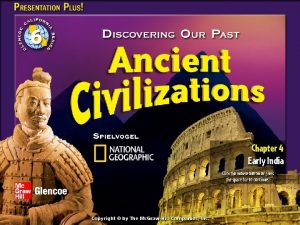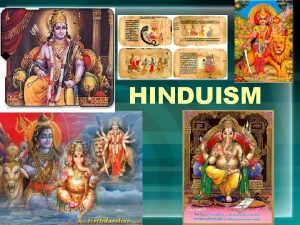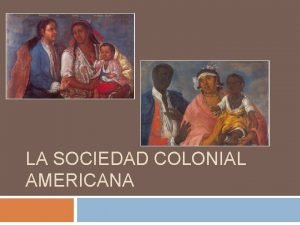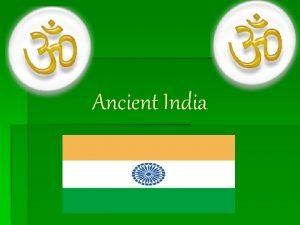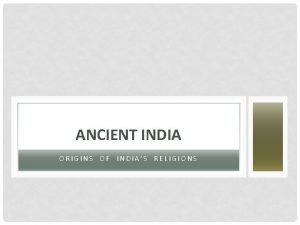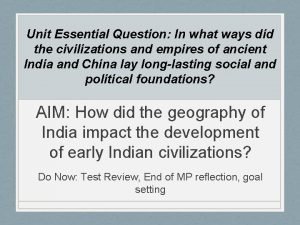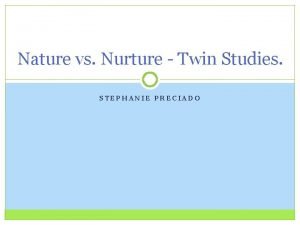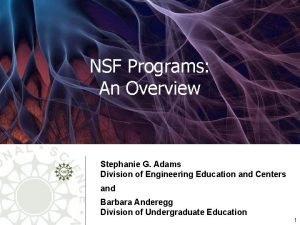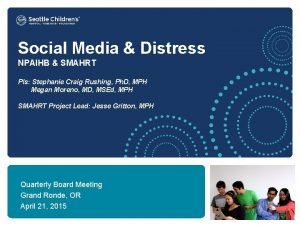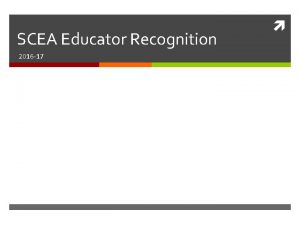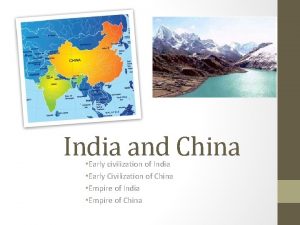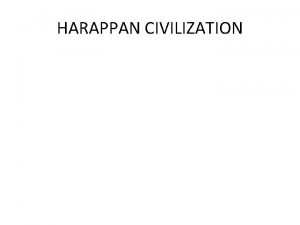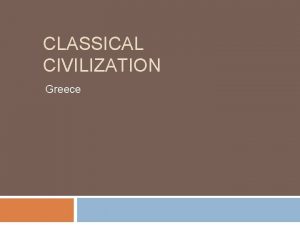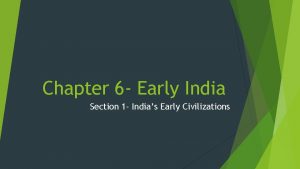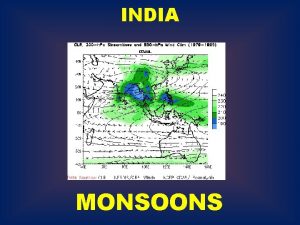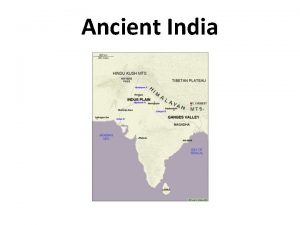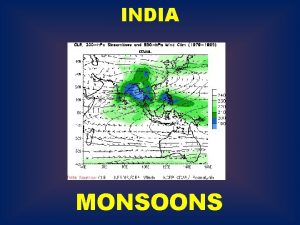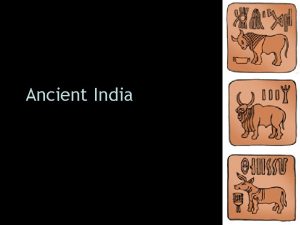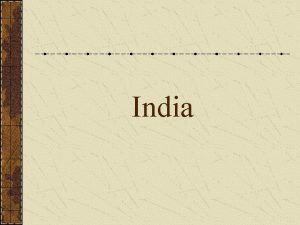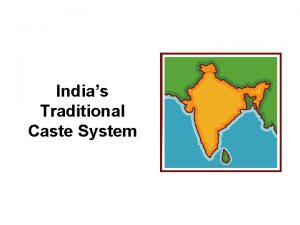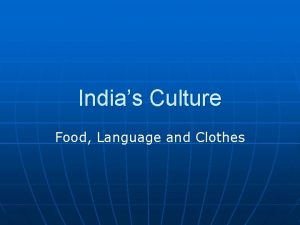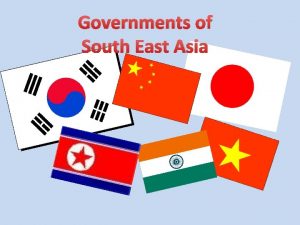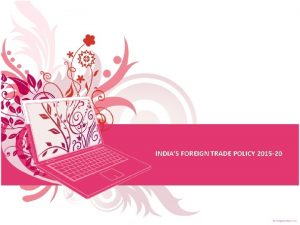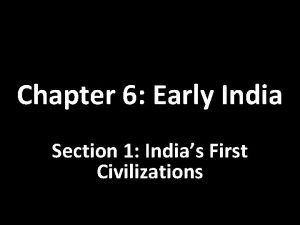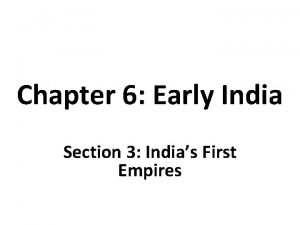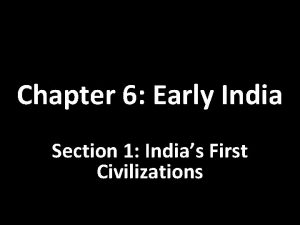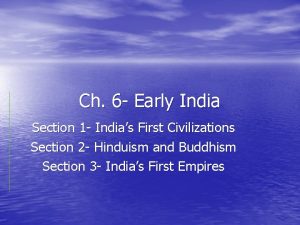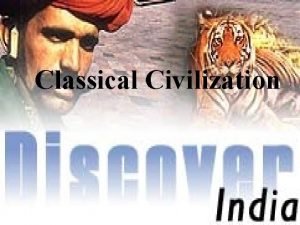Early India Stephanie O Indias Early Civilization Kelly



























- Slides: 27

Early India Stephanie O. - India’s Early Civilization Kelly M. - Hinduism Beth N. - Buddhism Stephanie B. – The Maurya Empire Shanda M. – The Gupta Empire

Standards 6. 5 Students analyze the geographic, political, economic, religious, and social structures of the early civilizations of India. 1. Locate and describe the major river system and discuss the physical setting that sup-ported the rise of this civilization. 2. Discuss the significance of the Aryan invasions. 3. Explain the major beliefs and practices of Brahmanism in India and how they evolved into early Hinduism. 4. Outline the social structure of the caste system. 5. Know the life and moral teachings of Buddha and how Buddhism spread in India, Ceylon, and Central Asia. 6. Describe the growth of the Maurya empire and the political and moral achievements of the emperor Asoka. 7. Discuss important aesthetic and intellectual traditions (e. g. , Sanskrit literature, including the Bhagavad Gita; medicine; metallurgy; and mathematics, including Hindu-Arabic numerals and the zero).

India’s Early Civilizations Stephanie O. Standards: 6. 5. 1, 6. 5. 2, & 6. 5. 4

Early India- 3000 BCE

The Land of India • Subcontinent • Himalaya • Ganges River • • Indus River • • South into Indian Ocean Empties into Arabian Sea Monsoons • • Winter- cold dry air Summer- warm wet air RAIN http: //www. indiavideo. org/travel/indianmonsoon-4289. php http: //www. youtube. com/watch? v=yjvg Ct. CSFno http: //www. youtube. com/watch? v=1 C Pj 0 QZCubk

India’s Early Civilization • River Valley • Harappa and Mohenjo-Daro • Large cities • 35, 00 people • First urban civilization in India Wheat Rice Cotton • Farmers • Plentiful food supply • Making tools • Building houses • Oven baked bricks Tamed Animals

Harappan Society • Special script • Seals and stamps • Government? • Royal palace • Temple • Both closely connected • Trade • Mesopotamians • 2300 BCE • Sailors • Coastline • Arabian Sea Harapan Priest-King

The Aryans 6. 5. 2 • Good by Harappan Civilization • 1500 BCE • Aryans migrated south • larger group • Cattle = possessions • Indus River Valley • 1500 BCE • Punjab/ Ganges/Deccan Plateau • 1000 BCE • Mixed cultures http: //www. glencoe. com/sites/common_assets/socialstudi es/in_motion_08/jat/p_242. swf

Aryans change • Raise cattle • Sacred • forbidden to use as food • Technology • Plow • Canals • Ganges • Farming land

Aryans change • Written Language • Sanskrit • Sacred songs • Poems • Prayers • Tribes-1500 -400 BCE • Led by • Raja(Prince) • Small kingdoms • Fought over • Cattle, treasure, women

Cast=Jeti • Brahmins • Religious ceremonies • Kshatriyas • Government • army • Vaisyas • farmers • Sudras • Manual labor • Untouchable • Dirty work

Center of life • Under one house • All extended family • Education • Men • Guru • 12 years • Women • Home schooled • Rights • Men • Property • Priesthood • School

India Marriage • Arrange • 90% even today • Divorced • Not allowed • No children • 2 nd wife • Suttee • Cremated • Great shame • Avoidance

Hinduism Kelly M. Standard: 6. 5. 3

Hinduism • Vocab • • Hinduism Brahman (BRAH-muhn) Reincarnation Dharma (DAHR-muh) Karma (KAHR-muh) Varna/jati moksa • Main Ideas • Came from ancient Aryans • Believed in many gods/godesses • reincarnation

Hinduism • History • One of oldest religions • Came from ancient belief of Aryans • 1500 BC arrived in India • Belief in many gods and godessess • Grew out of religious customs of many people over thousands of years. • Hindus thinks of all gods/goddesses as different parts of one universal spirit. This universal spirit is called Brahman.

Hinduism • Unlike most religions, Hinduism does not have a certain set of beliefs; ideas are more abstract. Hinduism is intertwined in every aspect of a Hindu’s life. • Believe in: • • • Brahman Kharma Dharma Idol worship Reincarnation moksa

Hinduism • Hindu’s believe that the soul does not join the Brahman (universal spirit) when one dies, the soul is reborn. • How you lived your previous life is a precursor to what varna (social class) you are born into in your next life. • This idea of passing through many lives is called reincarnation.

Hinduism • To earn the reward of a better life, one must perform their duty. • Dharma is the divine law, and requires people to perform the duties of their jati (social group) • Karma is also a part of everyday life. Karma is known as the consequences of how a person lives.

Hinduism • One can achieve moksa, spiritual goal in life, by performing yoga. • There are many different types of yoga, but all help connect the mind, body, and soul together as one.


Hinduism • Moral ideas: truthfulness, friendship, nonviolence, compassion, fortitude, self-control, purity. • Practices: daily idol worship, food offerings to gods, yoga, provide food for those who need it, serve guests with love and respect.

Hindu Temples/ Shrines

Four Stages of Life • Student Stage: 0 -18 • Student lives at home, studies Vedas, learns habits and skills for future. • Householder Stage: begins right after marriage • Attention is turned towards the world: family, career, community • Retirement Stage: begins after birth of grandchild • Come to terms of who we are, reflection on life • Forest Dweller/Ascetic Stage: begin by leaving home, carrying out spiritual existence in the country • Man leaves home and all possessions behind, and lives a detached life away from everyone else. • Stage is optional; one takes on this stage if they never want to return to the world, or be reincarnated.

Major Hindu Gods and Goddesses Name Realm • Brahma • Creater of the world • Vishnu • Preserver of the world • Siva • Destroyer of the world • Ganesha • Lord of existing beings; remover of obstacles • Krishna • Teacher of the world • Lakshmi • Goddess of light, beauty • Surya • God of the sun • Indra • King of the gods, ruler of heavens • Saraswati • Goddess of knowledge, music, art • Parvati • Universal mother

Siva Ganesha

 Indias first civilization
Indias first civilization What is the caste system
What is the caste system Indias major religion
Indias major religion Sociedad colonial americana
Sociedad colonial americana Indias first empire
Indias first empire Indias first empire
Indias first empire Indias religions
Indias religions Flota de indias ruta
Flota de indias ruta Indias religions
Indias religions Indus valley civilization sites map
Indus valley civilization sites map The history of gymnastics
The history of gymnastics Chapter 9 lesson 1 early civilizations
Chapter 9 lesson 1 early civilizations Early cpr and early defibrillation can: *
Early cpr and early defibrillation can: * Daphne goodship and barbara herbert
Daphne goodship and barbara herbert Nicholas bevins
Nicholas bevins Stephanie g. adams
Stephanie g. adams Stephanie jones
Stephanie jones Giraffe conservation foundation
Giraffe conservation foundation Stephanie ciccarelli
Stephanie ciccarelli Stephanie lacambra
Stephanie lacambra Stephanie craig rushing
Stephanie craig rushing Stéphanie besnier
Stéphanie besnier Stephanie j bryant
Stephanie j bryant Stephanie sinclair
Stephanie sinclair Stephanie nord
Stephanie nord Stephanie wendel
Stephanie wendel Stephanie beauceron
Stephanie beauceron Stephanie wong dvc
Stephanie wong dvc
